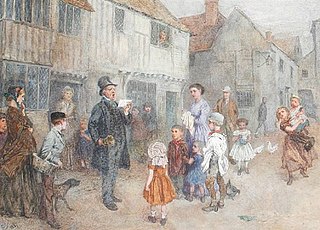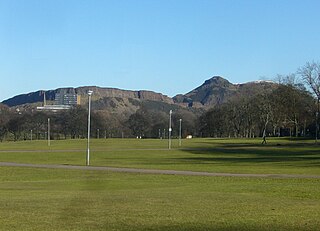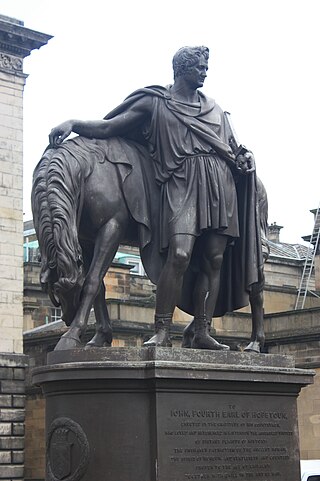
Midlothian is a historic county, registration county, lieutenancy area and one of 32 council areas of Scotland used for local government. Midlothian lies in the east-central Lowlands, bordering the City of Edinburgh council area, East Lothian and the Scottish Borders.

Margaret of Denmark was Queen of Scotland from 1469 to 1486 by marriage to King James III. She was the daughter of Christian I, King of Denmark, Norway and Sweden, and Dorothea of Brandenburg.

Dalkeith is a town in Midlothian, Scotland, on the River Esk. It was granted a burgh of barony in 1401 and a burgh of regality in 1540. The settlement of Dalkeith grew southwestwards from its 12th-century castle . Dalkeith has a population of 12,342 people according to the 2011 census.

John Kay was a Scottish caricaturist and engraver.

A town crier, also called a bellman, is an officer of a royal court or public authority who makes public pronouncements as required.

Newington is a neighbourhood of southern Edinburgh, Scotland. Developed from the early 19th century, it is an affluent, predominantly residential area.
Academic dress at the University of St Andrews involves students wearing distinctive academic gowns whilst studying at the University of St Andrews. Undergraduate gowns in Scotland were once common at all the ancient universities of Scotland, with each having its own distinctive style. St Andrews undergraduates wear either a scarlet gown if they are part of the United College and studying in the Faculties of Arts, Medicine and Science, or a black gown if they are part of St Mary's College and studying in the Faculty of Divinity.

The Tron Kirk is a former principal parish church in Edinburgh, Scotland. It is a well-known landmark on the Royal Mile. It was built in the 17th century and closed as a church in 1952. Having stood empty for over fifty years, it was used as a tourist information centre for several years in the mid 2000s and, more recently, was the site of the Edinburgh World Heritage Exhibition and John Kay’s book and gift shop.

The Burgh Muir is the historic term for an extensive area of land lying to the south of Edinburgh city centre, upon which much of the southern part of the city now stands following its gradual spread and more especially its rapid expansion in the late 18th and 19th centuries. The name has been retained today in the partly anglicised form Boroughmuir for a much smaller district within Bruntsfield, vaguely defined by the presence of Boroughmuir High School, and, until 2010, Boroughmuirhead post office in its north-west corner.
Lady Jean Stewart, was an illegitimate daughter of King James V of Scotland by his mistress, Elizabeth Bethune.

Beggars' badges were badges and other identifying insignia worn by beggars beginning in the early fifteenth century in Great Britain and Ireland. They served two purposes; to identify individual beggars, and to allow beggars to move freely from place to place.

Thomas Elder of Forneth, was a Scottish wine merchant who served as Lord Provost of Edinburgh from 1788 to 1790.
David Paton was a Scottish artist active between 1660–1700.

Thomas Campbell was a Scottish sculptor in the early 19th century. He has several important public works, most notably a statue of Sarah Siddons in Westminster Abbey. He also has several works in the National Gallery in London. He was heavily patronised by the British aristocracy, as evidenced by his works.
Henry Grieve FRSE was a Scottish minister who served as Moderator of the General Assembly of the Church of Scotland in 1783. He was a co-founder of the Royal Society of Edinburgh in the same year. He was also one of the Deans in the Chapel Royal in Edinburgh and Chaplain in Ordinary to King George IV.
Alexander Kincaid Mackenzie (1768–1830) was a 19th-century Scottish merchant who served as Lord Provost of Edinburgh from 1817 to 1819.

Sibilla "Sibbie" Hutton was a Scottish milliner and shopkeeper in 18th century Edinburgh. She became well known for operating a millinery in what today is Edinburgh City Chambers. She was a target of caricature for her fashion sense and "stout"ness.

William Paul was a minister of the Church of Scotland who was patriarch to a number of eminent Scottish ministers. He was Chaplain in Ordinary to King George III.

Thomas Randall Davidson (1747–1827) was a Church of Scotland minister and landowner.
Thomas Alison (1860–1931) was a Scottish painter whose main period of activity was 1880–1914. Principally known for Landscape painting, he also produced portraits and other works. He lived in Dalkeith, Midlothian, and also worked in Spain.














